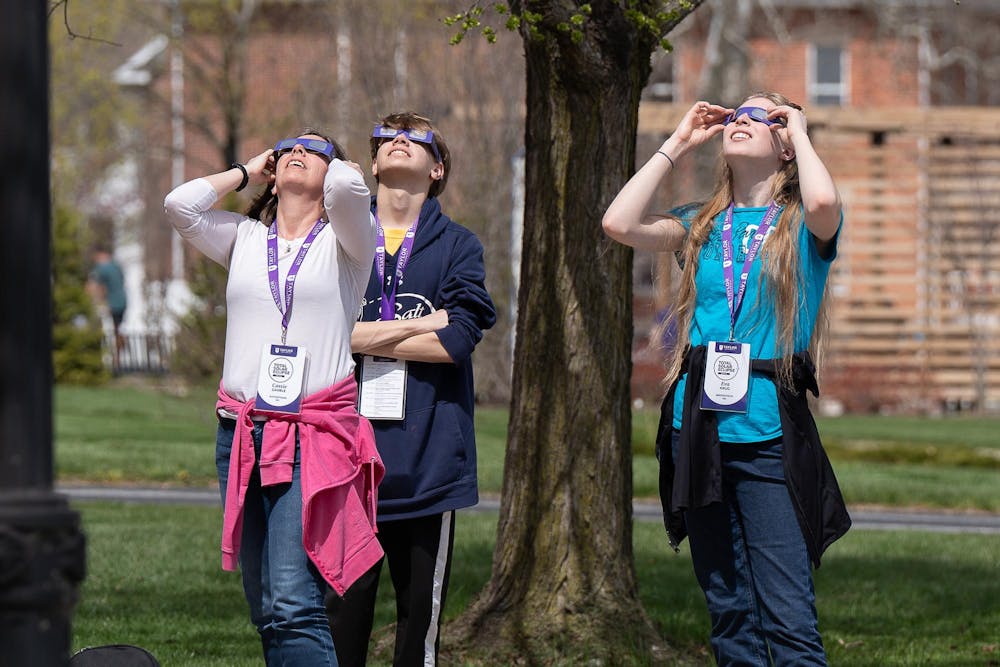At 3:08 p.m., the town of Upland went dark. Three minutes later, daylight returned.
After nearly two years of planning, Taylor University welcomed 2,120 guests who visited campus to experience the 2024 total solar eclipse April 8, Peter Staritz, associate professor of physics & engineering, said.
Complete with a multitude of events including guest lectures, a special chapel service, balloon launches, special lessons and mini projects, the University’s eclipse day was spearheaded by Staritz and funded through a $20,000 grant from the Indiana Space Grant Consortium.
Through the grant, Taylor was able to purchase 5,200 solar glasses for visitors and the community. The University also paid student workers to research, teach and prepare lesson plans as well as assemble various components for the event.
“They don't happen that often in a geographic region,” he said. “If we didn't have airplanes and [a] willingness to drive, you know, 16 hours, you would really just see one of these in a lifetime.”
Locations this year within the path of totality (spanning from Texas to Maine) experienced darkness for 3.5-4 minutes. People in these places were able to view the sun’s corona with the naked eye for a brief amount of time.
The initial plan was to bring middle school and high school students from outside the path of totality to Taylor to experience the eclipse. Over time, the event expanded to serve the local community as well, Staritz said.
Staritz recruited David McGinness, director of student teaching and assistant professor in education, to prepare various science lessons for visiting middle and high school students. MaryGrace Osborn, senior secondary math education major, organized the lesson plans according to two age groups and created learning materials.
“I think all of us that are involved in this [event planning] really are just wanting people to see the glory of God in nature and just how God has made things so uniquely in his creation,” McGinness said.
Over 520 students from public schools, Christian schools and homeschoolers visited Taylor.
All participating students engaged in three lessons, created a solar viewer and witnessed a balloon launch. Lessons included: “The Sun’s Big Yo,” which demonstrated the scale of the solar system; “Illumination/Shadow,” which explained what a Total Solar Eclipse is; and “Environmental Phenomena,” talking about the effects of the eclipse.
Thirty-five Student Ambassadors — consisting of education majors experienced in student teaching — taught each of the 20-minute lessons to 27 different groups on-campus, McGinness said.
“I feel like one of my goals was to make sure when editing them [the lessons] and making them were just for students to actually understand what's happening,” Osborn said.
Alongside the teaching team, a separate group arranged balloon launches throughout the day. NearSpace Education provided Taylor’s team with balloon launch equipment.
Maddie Holder, a junior physics major, was one of the students who participated in launching the balloons.
The launches consisted of releasing two 800-gram high-altitude balloons. Each had a parachute and package called a “payload” consisting of GPS systems and a camera as well as UV, pressure and temperature sensors, Holder said.
Once filled, the balloons reached up to a 5- to 6-foot diameter. There were a total of eight different launch teams on campus.
Taylor launched two of what was over 650 balloon launches in the United States, according to the Nationwide Eclipse Ballooning Project.
Amongst the teams were outside universities including the University of North Dakota, University of Michigan and St. Catherine’s University, who partnered with Taylor to launch their own balloons on Taylor’s campus on the day of the eclipse.
Additionally, East Brook High School launched high-altitude balloons on campus with NearSpace Education also releasing two balloons at NearSpace Park in Upland.
Tom Foltz, NearSpace Education director of education at training, said the balloons can track data in the atmosphere such as temperature, pressure, humidity, solar rays, weather patterns and jetstreams. Once in the thinner portion of the atmosphere, the balloons expand from their 4- to 6-foot length to be approximately 30-40 feet across, he said.
Once the balloon pops, the parachute allows for the payload to continue a controlled descent back to Earth.
Amongst the eclipse festivities were also two lectures: one from Katrina Koehler, assistant professor of physics at Houghton University on “A Data-Driven Story of the Great Commission,” and another from Benjamin Lawson, visiting assistant professor of physics at Taylor University, on the actual causes and effects of the total eclipse.
For the first hour before totality and an hour afterward, students and staff from Taylor’s Wolfe Observatory live streamed the eclipse. They used astrophotography digital cameras attached to two telescopes: the Celestron Edge HD 8 as well as the Askar 40MM FMA180 Pro. They also captured and streamed images using a Coronado 90mm Solarscope II.
The Askar FMA180 Pro was provided by Southern Illinois University (SIU) as a part of the Dynamic Eclipse Broadcast Initiative (DEBI) to create thousands of stacked images across the entire path of the eclipse.
“We’ll be taking data locally and then providing it to them (DEBI),” Rob Cartwright, physics and engineering lab manager, said. “One of the things that happens to get great images is that you stack images. So, you know, [there could be] 50, or 100 or 300. We'll stack images for 45 seconds, and then they get reduced down into a single image.”
The Total Solar Eclipse is expected to take place again in North America in 2044 with the next total eclipse in Indiana taking place in 2099, Staritz said. The last total solar eclipse in Upland took place in 957, with the next anticipated one in Upland to be in 2505, Lawson said in his lecture.
“I often tell my students God is our friend — the Word says God is our friend,” Staritz said. “But he's also creator of the universe, Lord of all creation. He's much bigger than that. And we need more opportunities to think less of ourselves and more of him.”





